#Wolf Rayet
Explore tagged Tumblr posts
Text

Nebulous Realm of WR 134 ©
#stars#space#astrophotography#wolf rayet#galaxy#planet#universe#nasa#solar system#astronomy#night sky#cosmos
973 notes
·
View notes
Text
james webb has snapped an image of a rare wolf-rayet star, a star phase that occurs in only some stars before they go supernova!! it’s super cool that we were able to see this, especially since you can see the star “shedding” its outer layers, resulting in the nebula you can see around it :D
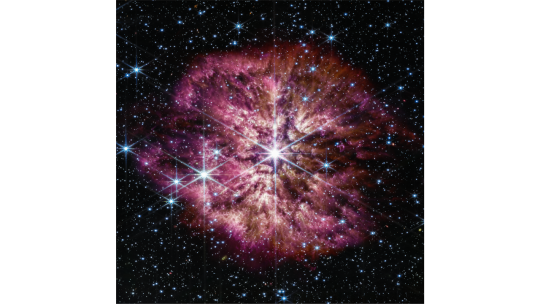
#aspaceinthecosmos#just jupiter#james webb#jwst#james webb space telescope#outer space#astrophotography#stars#wolf rayet#astronomy
348 notes
·
View notes
Text
my husband

character by @arcxis-84
art by me, @the-ace-ofhearts !!
THIS MAN HAS ME WEAK.
I’m going to steal him away and make him my bride
yes I said bride. someone’s gotta wear the dress, people /hj
I don’t think he’s from any particular fandom, but I’m not too sure lol
he’s just a little OC made by my bf lol
I say little and then Rayet is like the embodiment of the most powerful star by the same name 💀
#doodle#just for fun#drawing#artwork#oc#my art <3#oc art#not my oc#not my character#oc fanart#original character#not from this world#out of this world#night sky#galaxy#space#cosmos#outer space#constellations#fandomless oc#imagination#i love this man#wolf rayet#blue star#royal oc#please reblog#reblog please#fanart#rayet supremacy
5 notes
·
View notes
Text

For a fan meet & greet, Trinity wore the Circus Wave UV Catsuit from Wolf Rayet (£105.00) along with the Alien Superstar Trench Coat & Atomic Traitor Boots, both from Club Exx and both are sold out
#Trinity#Trinity Fatu#Circus Wave UV Catsuit#catsuit#catsuits#Wolf Rayet#Alien Superstar Trench Coat#coat#coats#Atomic Traitor Boots#boot#boots#club exx#women of wrestling fashion#impact wrestling
7 notes
·
View notes
Text
James Webb Space Telescope Captures Stunning Image of WR 124 star
On March 14, 2023, The James Webb Space Telescope, NASA's latest and most advanced observatory, has released an awe-inspiring image of the star WR 124, located about 15,000 light-years away in the constellation Sagittarius. Read full article here

16 notes
·
View notes
Text
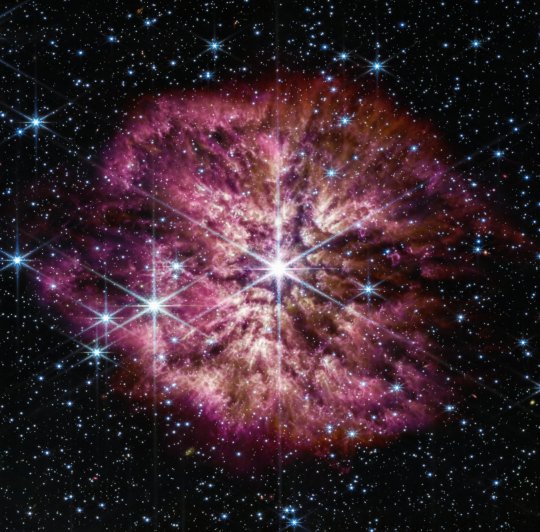
Wolf-Rayet Stars
Wolf-Rayet yıldızları (ayrıca WR yıldızları), evrim geçirmiş olağanüstü büyüklükte (20 güneş kütlesinden fazla) yıldızlardır ve kütlelerini 2000 km/s hızına ulaşabilen çok yeğin yıldız rüzgârı nedeniyle kaybetmektedirler.
5 notes
·
View notes
Text
All about Wolf-Rayet stars
Some facts about Wolf-Rayet Stars
Wolf-Rayet stars are named the ‘most massive and brightest stars known’. This is because their temperatures start at 30,000 degrees celsius. They also have strong stellar winds which blow away their outer atmospheres, revealing the stars’ inner layers. Blowing at over ten million miles per hour, the stars shed about 2 thousand billion billion tons of material every year. That’s equivalent to the mass of three Earths! Since these stars have trouble holding themselves together, they don’t last very long, burning up their fuel quickly and blasting mass into space, eventually tearing themselves apart. They are usually members of binary stars with O or B stars (types of stars classed by temperature) as companions.vd
The discovery
The French astronomers Charles Wolf (1827-1918) and Georges Rayet (1839-1906) co-discovered this type of unusual, hot star, which are now named after them. They discovered Wolf-Rayet stars by using the Paris Observatory’s 40cm Foucault telescope in 1867 to observe three stars whose spectra had strong, broad emission lines, but few absorption lines, which is unusual for stars.
For decades, the reason for these emission bands remained a mystery. Eventually, it was discovered that these lines resulted from the presence of helium, which was discovered in 1868, one year after the original observation. E.C.Pickering also compared Wolf-Rayet spectra with nebula spectra, and noticed similarities between them. This led to his discovery that some or all Wolf-Rayet stars are in the centre of nebulae.
In 1929, doppler broadening (the broadening of spectral lines due to the Doppler effect caused by a distribution of velocities of atoms or molecules) was being used to explain the width of the emission bands. It was concluded that the gas surrounding Wolf-Rayet stars must be moving with velocities of 300-2400 km/s, and therefore they are continually ejecting gas into space. This produces an expanding envelope, or bubble, of nebulous gas. The force that ejects this gas was then discovered to be radiation pressure.
Later, Rayet became Director of the Bordeaux Observatory, and to this day, we have discovered over 500 Wolf-Rayet stars in our galaxy.
About the most massive star, R136a1, which is a Wolf-Rayet star
R136a1 is the most massive star known, which is a Wolf-Rayet star. It is 163,000 light years away from the Sun, and is located in the Large Magellanic Cloud. It is also part of the R136 super star cluster, and has the mass of 315 suns. Despite being the most massive star known and shining 9 million times brighter than the sun, it requires a telescope to see. An interesting fact about R136a1 is that it defies what scientists know about how stars form. A popular hypothesis among scientists is that R136a1 did not form directly from the collapse of a molecular hydrogen cloud, but rather from two massive stars colliding.
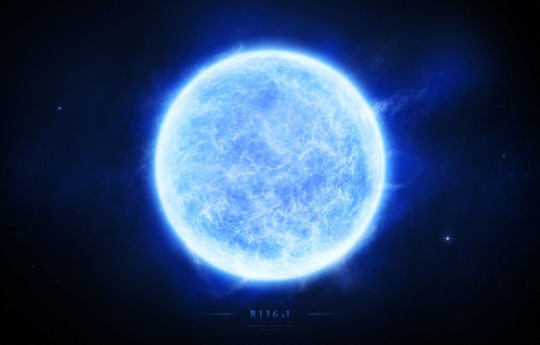
About WR 124, a Wolf-Rayet star
WR 124 is 15,000 light years away from the Sun. Its spectral type is WN, meaning it falls into the hottest ‘O’ spectral type of stars, but is referred to as ‘W’ from Wolf-Rayet. The ‘N’ means it shows strong emission lines of nitrogen. WR 124 is the glowing star in the centre of a huge, fiery nebula. WR 124 has a surface temperature of around 50,000 degrees celsius, and is one of the hottest known Wolf-Rayet stars. It is a massive, unstable star which is blowing itself apart. Its material is travelling at up to 150,000kph. The nebula that surrounds the star, M1-67, consists of vast arcs of glowing gas which is violently expanding outwards into space. M1-67 is quite young, only 10,000 years old, and it contains clumps of material within it with masses 30 times the mass of Earth and diameters of 150 billion km.

WR 7, another Wolf-Rayet star
WR 7 is also 15,000 light years away from the Sun. It produced the emission nebula NGC 2359, which is also known as Thor’s Helmet because it looks like a helmet with wings. The nebula has a diameter of around 30 light years, and has WR 7 at its centre. Its surface temperature is between 30,000 degrees celsius and 50,000 degrees celsius, which is 6 to 10 times the temperature of the sun. It is an incredibly unstable star, ejecting stellar material into the interstellar medium at speeds which approach 7.2 million kph! Even though it is a massive star, it loses the mass of the Sun every thousand years. Material ejected from the star is done so in a spherical manner, which produces a bubble of material. This bubble has been shaped further by its interactions with the surrounding interstellar medium. WR 7 lies at the edge of a dense, warm molecular cloud, which is unusual.

6 notes
·
View notes
Text
Why is the shape of Thor’s Helmet so complex?

Bubbles and Arcs in NGC 2359 - January 2nd, 1997.
"What caused the bubbles and arcs in NGC 2359? The main suspect is the Wolf-Rayet star in the center of one of the bubbles - visible slightly below and to the right of the center of the above photograph. Most Wolf-Rayet stars are known to be massive, highly luminous stars that continually cast off material in a stellar wind - which commonly form bubbles in the interstellar medium. But the unusual structure of the NGC 2359 arcs indicate something more complex is going on. Is the star moving supersonically? Is there another energetic star in the vicinity? Future observations may give more pieces to this picturesque puzzle."
83 notes
·
View notes
Text
Sh2-308: A Dolphin Shaped Star Bubble

Which star created this bubble? It wasn't the bright star on the bubble's right. And it also wasn't a giant space dolphin. It was the star in the blue nebula's center, a famously energetic Wolf-Rayet star. Wolf-Rayet stars, in general, have over 20 times the mass of our Sun and expel fast particle winds that can create iconic looking nebulas. In this case, the resulting star bubble spans over 60 light years, is about 70,000 years old, and happens to look like the head of a dolphin. Named Sh2-308 and dubbed the Dolphin-Head Nebula, the gas ball lies about 5,000 light years away and covers as much sky as the full moon -- although it is much dimmer. The nearby red-tinged clouds on the left of the featured image may owe their glow and shape to energetic light emitted from the same Wolf-Rayet star.
Image Credit & Copyright: Aleix Roig (AstroCatInfo)
0 notes
Text
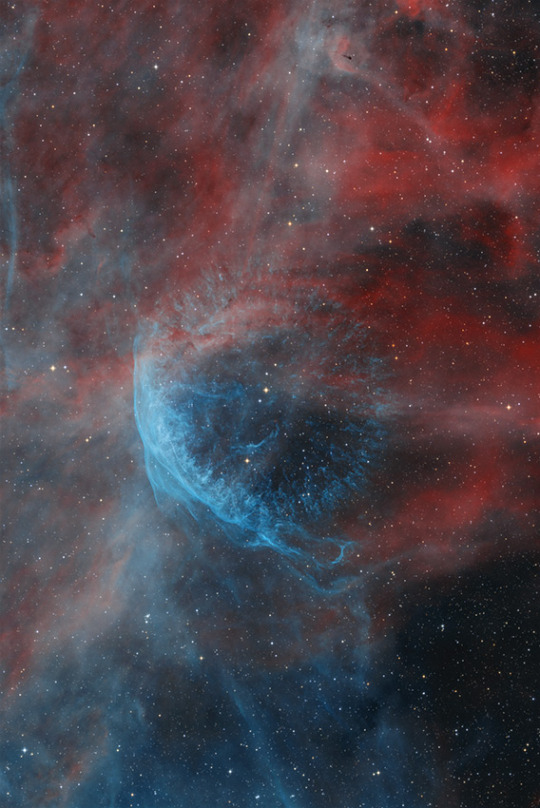
Big Eye in Cygnus, Wolf-Rayet 134 © xlong
#stars#space#nasa#night sky#astrophotography#nebula#solar system#planet#galaxy#astronomy#cosmos#universe#planets#wolf rayet
2K notes
·
View notes
Text

The Dolphin Head Nebula, Sh2-308 // TRE
#astronomy#astrophotography#nebula#emission nebula#wolf-rayet#wolf rayet#dolphin head nebula#Sh2-308#canis major
456 notes
·
View notes
Text
“I paint you, you treat me”

I kept forgetting to post this cause I’ve been so busy, but this was my gift for the ever so lovely @sincerelywhistler ‘s birthday not so long ago of their Misery Demon OC (and loml) Wolf-Rayet<3
One of the best people I’ve gotten to meet since joining this fandom. Who knew being cool, sexy, mysterious, hilarious, and creative could all fit into one person am I right?
#if yall knew the love I had for him#HE’S JUST SOOOO#I’m so sorry Cebalrai#redacted audio#redacted asmr#redacted verse#redactedaudio#redactedasmr#redactedverse#wolf-rayet#redacted misery demon#Whistler’s OCs#(others) redacted ocs#pycthsketches
147 notes
·
View notes
Text

Wolf Rayet star
109 notes
·
View notes
Text
What Are Wolf-Rayet Stars?
Wolf-Rayet stars are among the most fascinating objects in the universe, characterized by their intense luminosity, high temperatures, and strong stellar winds. These massive stars are in the later stages of their lives and are known for their complex and varied spectra, which provide astronomers with a wealth of information about their physical properties and evolution. In this article, we will explore the remarkable WR 124 star photographed by the James Webb Space Telescope. WR 124 is located 15000 light years away in the constellation Sagittarius. Read more here
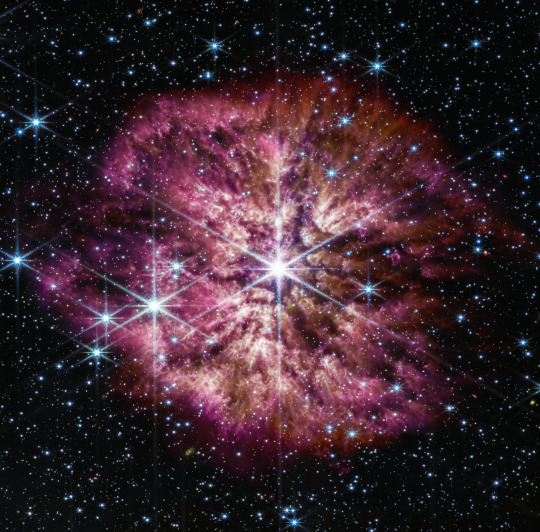
7 notes
·
View notes
